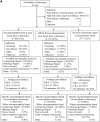Adherence to Recommendations for Repeat Surveillance After Publication of New Postpolypectomy Guidelines
- PMID: 39130145
- PMCID: PMC11307611
- DOI: 10.1016/j.gastha.2022.07.014
Adherence to Recommendations for Repeat Surveillance After Publication of New Postpolypectomy Guidelines
Abstract
Background and aims: The 2012 and 2020 US Multi-Society Task Force postpolypectomy guidelines have recommended progressively longer surveillance intervals for patients with low-risk adenomas (LRAs). These guidelines require data from past colonoscopies. We examined the impact of the 2012 guidelines for second surveillance on clinical practice, including the availability of prior colonoscopy data, with the aim of informing the implementation of the 2020 guidelines.
Methods: We identified surveillance colonoscopies at Stanford Health Care and the Palo Alto Veterans Affairs Health Care System in 3 periods: preguideline (March-August 2012), postguideline (January-June 2013), and delayed postguideline (July-September 2017). We collected data on the most recent previous colonoscopy, findings at the study entry surveillance colonoscopy, and recommendations for subsequent surveillance.
Results: Among 977 patients, the most recent prior colonoscopy data were available in 78% of preguideline, 78% of postguideline, and 61% of delayed postguideline cases (P < .001). The fraction of surveillance colonoscopy reports that deferred recommendations awaiting pathology increased from 6% to 11% in preguideline and postguideline to 59% in delayed postguideline cases (P < .001). Overall adherence to guidelines for subsequent surveillance was similar in all 3 periods (54%-67%; P = .089). In the postguideline and delayed postguideline periods combined, a 10-year subsequent surveillance interval was recommended in 0 of 29 cases with LRA followed by normal surveillance colonoscopy.
Conclusion: In patients undergoing surveillance, prior colonoscopy data were not always available and recommendations were often deferred awaiting pathology. Adherence to subsequent surveillance guidelines was suboptimal, especially for LRA followed by normal colonoscopy. Strategies addressing these gaps are needed to optimize implementation of the updated 2020 postpolypectomy guidelines.
Keywords: Colorectal Adenoma; Colorectal Polyps; Guidelines; Implementation; Surveillance.
© 2023 The Authors.
Figures




Similar articles
-
Guidelines for colonoscopy surveillance after polypectomy: a consensus update by the US Multi-Society Task Force on Colorectal Cancer and the American Cancer Society.CA Cancer J Clin. 2006 May-Jun;56(3):143-59; quiz 184-5. doi: 10.3322/canjclin.56.3.143. CA Cancer J Clin. 2006. PMID: 16737947
-
Guidelines for colonoscopy surveillance after polypectomy: a consensus update by the US Multi-Society Task Force on Colorectal Cancer and the American Cancer Society.Gastroenterology. 2006 May;130(6):1872-85. doi: 10.1053/j.gastro.2006.03.012. Gastroenterology. 2006. PMID: 16697750 Review.
-
Real-world compliance with the 2020 U.S. Multi-Society Task Force on Colorectal Cancer polypectomy surveillance guidelines: an observational study.Gastrointest Endosc. 2023 Feb;97(2):350-356.e3. doi: 10.1016/j.gie.2022.08.020. Epub 2022 Aug 23. Gastrointest Endosc. 2023. PMID: 35998689
-
Physician Non-adherence to Colonoscopy Interval Guidelines in the Veterans Affairs Healthcare System.Gastroenterology. 2015 Oct;149(4):938-51. doi: 10.1053/j.gastro.2015.06.026. Epub 2015 Jun 26. Gastroenterology. 2015. PMID: 26122143
-
Colonoscopy: a review of its yield for cancers and adenomas by indication.Am J Gastroenterol. 1995 Mar;90(3):353-65. Am J Gastroenterol. 1995. PMID: 7872270 Review.
Cited by
-
Adherence to Follow-Up Colonoscopy After a Positive Stool-Based Test in Patients Aged 45-49 Years: Real-World Differences Between Multitarget Stool DNA Testing and Fecal Immunochemical or Fecal Occult Blood Testing.Gastro Hep Adv. 2025 May 16;4(9):100706. doi: 10.1016/j.gastha.2025.100706. eCollection 2025. Gastro Hep Adv. 2025. PMID: 40688388 Free PMC article.
References
-
- Hardcastle J.D., Chamberlain J.O., Robinson M.H., et al. Randomised controlled trial of faecal-occult-blood screening for colorectal cancer. Lancet. 1996;348:1472–1477. - PubMed
-
- Mandel J.S., Church T.R., Bond J.H., et al. The effect of fecal occult-blood screening on the incidence of colorectal cancer. N Engl J Med. 2000;343:1603–1607. - PubMed
LinkOut - more resources
Full Text Sources
Miscellaneous

